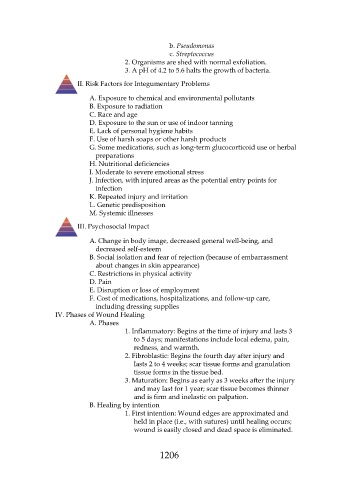Page 1206 - Saunders Comprehensive Review For NCLEX-RN
P. 1206
b. Pseudomonas
c. Streptococcus
2. Organisms are shed with normal exfoliation.
3. A pH of 4.2 to 5.6 halts the growth of bacteria.
II. Risk Factors for Integumentary Problems
A. Exposure to chemical and environmental pollutants
B. Exposure to radiation
C. Race and age
D. Exposure to the sun or use of indoor tanning
E. Lack of personal hygiene habits
F. Use of harsh soaps or other harsh products
G. Some medications, such as long-term glucocorticoid use or herbal
preparations
H. Nutritional deficiencies
I. Moderate to severe emotional stress
J. Infection, with injured areas as the potential entry points for
infection
K. Repeated injury and irritation
L. Genetic predisposition
M. Systemic illnesses
III. Psychosocial Impact
A. Change in body image, decreased general well-being, and
decreased self-esteem
B. Social isolation and fear of rejection (because of embarrassment
about changes in skin appearance)
C. Restrictions in physical activity
D. Pain
E. Disruption or loss of employment
F. Cost of medications, hospitalizations, and follow-up care,
including dressing supplies
IV. Phases of Wound Healing
A. Phases
1. Inflammatory: Begins at the time of injury and lasts 3
to 5 days; manifestations include local edema, pain,
redness, and warmth.
2. Fibroblastic: Begins the fourth day after injury and
lasts 2 to 4 weeks; scar tissue forms and granulation
tissue forms in the tissue bed.
3. Maturation: Begins as early as 3 weeks after the injury
and may last for 1 year; scar tissue becomes thinner
and is firm and inelastic on palpation.
B. Healing by intention
1. First intention: Wound edges are approximated and
held in place (i.e., with sutures) until healing occurs;
wound is easily closed and dead space is eliminated.
1206

